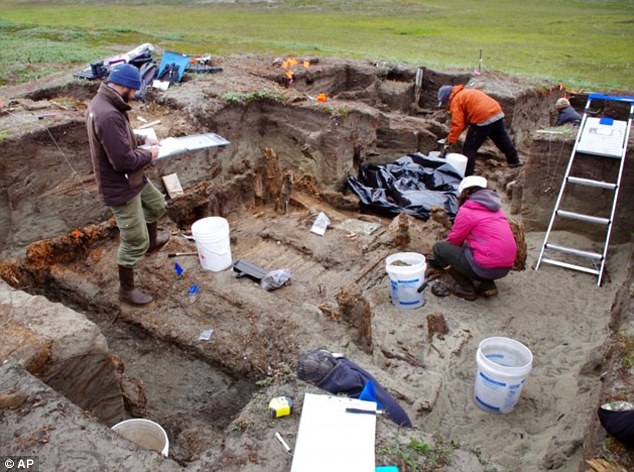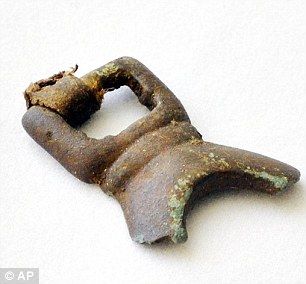
A bronze 'buckle' believed to be 1,400 years old had been unearthed in Alaska for the first time - and archeologists are mystified about how it got there.
The artifact was found in sediment as they dug on a site where a 1,000-year-old Inupiat home was built.
The two inch by one inch object - which seems to have been molded - appears to have been part of a harness.
How it got to Alaska is a mystery - although it is thought it may have been brought by Eskimos from East Asia around 1,400 years ago and passed down through the generations.
'The object appears to be older than the house we were excavating by at least a few hundred years,' research assistant John Hoffecker said.
The 'buckle', found at the house near Cape Espenberg on Alaska's Seward Peninsula, has a rectangular bar connected to a broken circular ring.
Archaeologist Owen Mason, a University of Colorado Boulder research affiliate, said the discovery was made as six houses were excavated.
The bronze artifact was found near the entryway to the house by University of California student Jeremy Foin, as he used a sifting screen.
A copper needle was found at another Cape Espenberg house. Early Alaskans were known to hammer copper into tools but there is no known metal casting in Alaska, Mr Mason said.
'It would be incredibly significant if there were metallurgy in Alaska, but I just don't see that being here,' Mason said.
The house site is within the Bering Land Bridge National Preserve and the metal is likely to have been brought from Korea, China, Manchuria or southern Siberia.
The researchers are looking for an East Asia expert to confer with on the bronze piece.
Mason said it's not likely the bronze piece was washed ashore after being dropped by a Russian explorer or a whaler.
'That's totally unlikely, in fact nearly impossible, considering where it is,' he said.
The excavated home was an inauspicious mound that was part of a marsh in a sand dune away from the current coast.
Purdue University Assistant Professor H. Kory Cooper, prehistoric metallurgical expert, will study the bronze piece.
Researchers recovered several thousand artifacts at Cape Espenberg, including harpoons used to kill seals, fishing spears and fishing lures.




Reader Comments
to our Newsletter